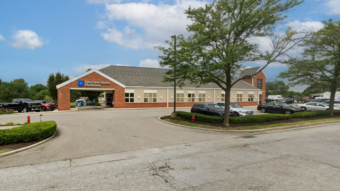Like flying cars and jetpacks, virtual reality (VR) is a technology that languished for years between promise and delivery. While the majority of us still commute in ground-based vehicles, the commercial viability of VR is finally here. And architects have been quick to adopt it.
There are two tiers of VR. There’s the cumbersome but powerful version that many visualize, where a user dons a headset and perhaps also uses a hand controller as they move about a virtual space. There’s also a smaller, more portable version that uses the ubiquitous cell phone to deliver a fixed-point view of a 360-degree space. Both are very functional and have a time and a place.
With the full-blown version, designers can load a Revit model and walk through a schematic design. This works really well for interior spaces, but less so for the outside of a building where one’s virtual self would have to jump around to experience the design.
Though fully navigable, the more robust VR models tend to be less polished virtual realities. As such, this technology is usually reserved for the design team to better visualize a space. It can also be particularly useful for a younger design professional who is still trying to integrate in their mind what the finished space will look like.
“That’s very helpful on the design side, when the younger staff gets to walk through the space that they are creating and see how their keystrokes are turning into reality,” said Craig Pryde, principal at KTGY Architecture + Planning.
For the designers, VR is another tool to help them more efficiently, more elegantly understand every aspect of a project. This could be as simple as exploring sightlines or a transition of materials, or it could be visually displaying wall stress, wind loads, solar heat gain or other engineering factors typically confined to building information modeling.
“Quite often, when you are working on a model, the designers tend to focus on one area or aspect of the project,” said Pryde. “With VR they can take a step back and look at the project the same way our client is looking at it. They can see it anew.”
While VR has become a potent design tool, it’s probably even more effective as a means of communication with the client, conveying the design aesthetic in a mode of reality that goes beyond looking at a static rendering. Depending on their experience and sophistication, a client may focus on the wrong things in a two-dimensional rendering, similar to a first-time homebuyer who can’t see past an ugly paint color.
“When we get to the point where we have a final concept design, then we can use virtual reality to more or less get confirmation of the renderings we’ve shown them, the floor plan, the material palate and so forth,” Pryde said. “It allows them to focus on everything as a full composition.”
KTGY sends links to the VR model out to their clients, but they also includes QR codes on design files that they send. With these, the client can scan the code and launch the cell phone version of the VR render whenever and wherever it is convenient.
“We’ve had a couple of clients where we’ve presented in the afternoon and the client pulls it up later at dinner and says ‘Hey, here’s what our project looks like.’ That’s where the excitement comes in,” Pryde said. “The smaller version is a lot more portable and they get to take a second look at it, spend more time and get more in depth.”
On the client side, VR is also a good intra-organization tool, allowing decision-makers in the firm to convey the design to or seek input from others, especially those on staff unaccustomed to seeing design modeling but that might have a valuable contribution to the specific project. Someone on the construction team would be focused on best practices during the build while a property manager would have insight on the layouts or materials that work best. A member of the leasing team might suggest ways to better take advantage of views, for example, to attract more potential tenants.
About two years ago, KTGY launched a research and development studio, where staff play around with project types or instances of design, to study some piece of design on the micro level. Pryde feels that VR has been an asset in this regard, as it helps to better convey some piece of design language to clientele or potential clients.
“We’re always looking for ways to enhance the design process, both for our staff and for our clients, because that’s what helps set us apart and makes us unique to the design industry,” said Pryde.



